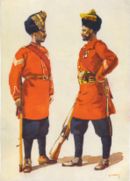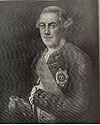Bengal Infantry Regiments: Difference between revisions
Symorsebrown (talk | contribs) m Typo |
|||
| Line 10: | Line 10: | ||
After the recapture of [[Calcutta]] in 1757, the Council of Madras ordered [http://en.wikipedia.org/wiki/Robert_Clive,_1st_Baron_Clive Robert Clive] to raise fighting units of [[sepoy|sepoys]] with officers from the [[Madras (Presidency)|Madras]] establishment. These units were called battalions, named after their commanding captains, and each comprised 42 Indian non-commissioned officers and 820 rank & file. There were 2 battalions in 1757, 4 battalions in 1758 and 17 battalions in 1763 three of which were destroyed at Patna. They were originally numbered (as the [[British Army]]) with the 1st being the oldest and the highest number being the youngest. In 1764 the battalions were numbered according to the seniority of their captains and totalled 19 battalions. In 1765 two more battalions were raised and the Bengal Army was divided into three brigades each with with one troop of cavalry, one company of artillery, one regiment of European infantry and seven battalions of native infantry. In 1766 six Provincial battalions were added and five of these were disbanded in 1773. | After the recapture of [[Calcutta]] in 1757, the Council of Madras ordered [http://en.wikipedia.org/wiki/Robert_Clive,_1st_Baron_Clive Robert Clive] to raise fighting units of [[sepoy|sepoys]] with officers from the [[Madras (Presidency)|Madras]] establishment. These units were called battalions, named after their commanding captains, and each comprised 42 Indian non-commissioned officers and 820 rank & file. There were 2 battalions in 1757, 4 battalions in 1758 and 17 battalions in 1763 three of which were destroyed at Patna. They were originally numbered (as the [[British Army]]) with the 1st being the oldest and the highest number being the youngest. In 1764 the battalions were numbered according to the seniority of their captains and totalled 19 battalions. In 1765 two more battalions were raised and the Bengal Army was divided into three brigades each with with one troop of cavalry, one company of artillery, one regiment of European infantry and seven battalions of native infantry. In 1766 six Provincial battalions were added and five of these were disbanded in 1773. | ||
===Clavering Reform === | ===Clavering Reform === | ||
[[Image:General Sir John Clavering KB.jpg|100px|thumb|right| ''Gen. Clavering'']] | |||
In 1775 [http://en.wikipedia.org/wiki/John_Clavering_(British_Army_officer) General John Clavering], commander-in-chief, gave the units in the three brigades sequential numbers which changed the number of every battalion except the 21st. In 1777 six battalions which had been raised under British officers for the Vizier of Oude were brought into HEIC service. In 1778 six battalions from the 1st Brigade were sent to Bombay for the 1st Maratha War and six new battalions raised to replace them. The battalions numbers were changed to 1st, 2nd, 4th, 5th, 6th and 7th Bombay Battalion and they were returned to Bengal in 1783. | In 1775 [http://en.wikipedia.org/wiki/John_Clavering_(British_Army_officer) General John Clavering], commander-in-chief, gave the units in the three brigades sequential numbers which changed the number of every battalion except the 21st. In 1777 six battalions which had been raised under British officers for the Vizier of Oude were brought into HEIC service. In 1778 six battalions from the 1st Brigade were sent to Bombay for the 1st Maratha War and six new battalions raised to replace them. The battalions numbers were changed to 1st, 2nd, 4th, 5th, 6th and 7th Bombay Battalion and they were returned to Bengal in 1783. | ||
Latest revision as of 08:13, 17 October 2011
| Bengal Army | |
|---|---|

| |
| Bengal Army | |
| List of Bengal Army Regiments | |
| Bengal Infantry Regiments | |
| Bengal Infantry Finder tool | |
| Bengal Artillery | |
| Bengal Horse Artillery | |
| Bengal Sappers and Miners | |
| East India Company Army | |
European Regiments
See also: European regiments
Three units were raised between 1652 and 1765 which became regiments of the British Army in 1861. Three further regiments were formed in 1858 with officers from Native Regiments which had mutinied but these were disbanded after the Indian Mutiny.
Indian Regiments
Beginnings
After the recapture of Calcutta in 1757, the Council of Madras ordered Robert Clive to raise fighting units of sepoys with officers from the Madras establishment. These units were called battalions, named after their commanding captains, and each comprised 42 Indian non-commissioned officers and 820 rank & file. There were 2 battalions in 1757, 4 battalions in 1758 and 17 battalions in 1763 three of which were destroyed at Patna. They were originally numbered (as the British Army) with the 1st being the oldest and the highest number being the youngest. In 1764 the battalions were numbered according to the seniority of their captains and totalled 19 battalions. In 1765 two more battalions were raised and the Bengal Army was divided into three brigades each with with one troop of cavalry, one company of artillery, one regiment of European infantry and seven battalions of native infantry. In 1766 six Provincial battalions were added and five of these were disbanded in 1773.
Clavering Reform

In 1775 General John Clavering, commander-in-chief, gave the units in the three brigades sequential numbers which changed the number of every battalion except the 21st. In 1777 six battalions which had been raised under British officers for the Vizier of Oude were brought into HEIC service. In 1778 six battalions from the 1st Brigade were sent to Bombay for the 1st Maratha War and six new battalions raised to replace them. The battalions numbers were changed to 1st, 2nd, 4th, 5th, 6th and 7th Bombay Battalion and they were returned to Bengal in 1783.
Formation of Regiments
In 1781 every battalion was increased to 1,000 men and designated a regiment commanded by a major and consisting of two battalions under a captain. The total was then 44 regiments. There was a further shuffling of numbers in 1783 and further disbanding had reduced the number to 37 regiments by 1784.
Battalions again
in 1786 the two battalions in each regiment were amalgamated and the strength reduced to 30 battalions. Shortly thereafter the three brigades were changed to six each with one European battalion and six native battalions - total 36 native battalions.
1796 Reforms
The 36 battalions of the Native Infantry Establishment were condensed into 12 regiments of two battalions each. 12 units became 1st Battalion, 12 units became 2nd Battalion and twelve units were absorbed by both battalions of each regiment. By 1823 the strength had increased to 34 two battalion regiments.
1824 Reforms
In 1824 the Native Infantry battalions were separated into 68 regiments. By the outbreak of the Mutiny these had increased to 74 regiments each composed of 10 companies of 100 privates, 2 native commissioned and 12 native non-commissioned officers. The numbering adopted in the lists found in the Category page is generally that of 1824 with the addition of pages for those battalions which were disbanded before the 1824 reorganisation.
1825-61
By 1846 the strength had grown to 81 regiments. two mutinies reduced this to 79 regiments by 1856. In 1857 51 regiments mutinied and 8 were disbanded. By 1861 4 more regiments had been disbanded and 16 were retained in the Bengal line.
Finding a regiment
To find the chronology of any regiment in the Bengal Native Infantry between 1757 and 1861, refer to the Bengal Infantry Finder.
See also
External Links
Bengal Native Infantry 1825 British Empire website
Bengal Native Infantry Wikipedia
Indian Infantry Regiments 1860-1914 By Michael Barthorp, Jeffrey J. Burn Google Books
Description of Bengal Infantry Regiments at the time of the Mutiny Google Books
Historical Books on-line
History of the Rise and Progress of the Bengal Army by Capt Arthur Broome 1850 (archive.org)
The History of the Bengal European Regiment by Lt-Col P R Innes 1885 (archive.org)
An historical account of the rise and progress of the Bengal Native Infantry, from its first formation in 1757, to 1796 by Captain Williams 1817 (archive.org)
The Standing Orders for the Bengal Native Infantry, with a translation into Oordoo, in the Roman, Persian, and Naguree Characters by Brevt. Capt. Samuel Cross Starkey, 7th Regiment B.N.I 1846 (Google Books)